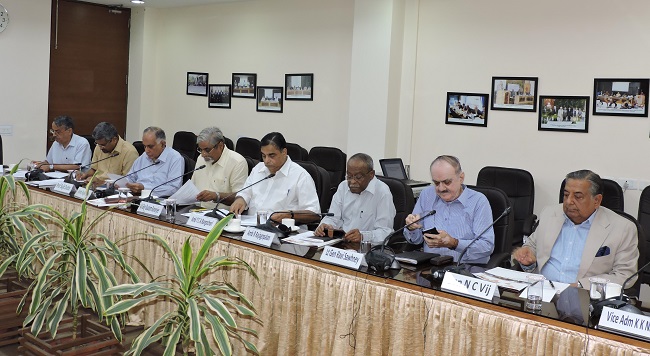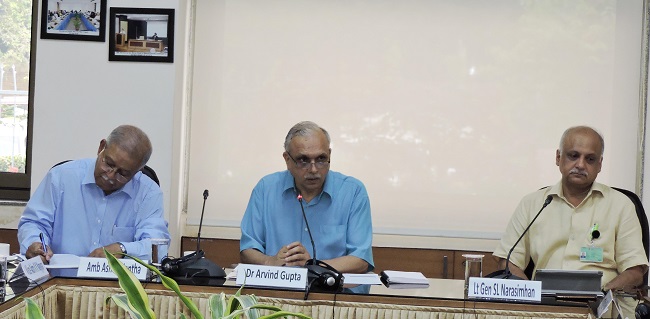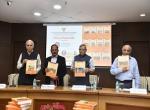The Vivekananda International Foundation (VIF) organised a Brainstorming Session on ‘India-China Relations: Global, Regional and Bilateral Context including Future Trajectory’ on 20 August 2018. Dr. Arvind Gupta, Director, VIF, delivered the opening remarks while Amb. Ashok Kantha and Lt Gen S L Narasimha made the presentations which were followed by a discussion. The discussion was attended by Vice Adm K.K Nayyar, Gen N.C. Vij, Amb. Kanwal Sibal, Lt Gen Ravi Sawhney, Lt Gen Gautam Banerjee, Amb. TCA Rangachari, Amb. Rajiv Sikri, Lt Gen A.K Ahuja, and Cmde Gopal Suri. The aim of the discussion was to discuss the need for a new approach in India-China Relations.

The Speakers focused on five major questions relating to the bilateral relations, as follows:-
- The Global situation today and its impact on India-China relations;
- The state of India-China relations, post-Wuhan, post-Qingdao and post-Johannesburg;
- Structural challenges in India-China relations;
- New template for India-China Relations;
- The future trajectory of India-China relations.
The discussion started with the overview of the evolving global situation. It was highlighted that in the present scenario, China was under marked pressure as the global situation has changed to its disadvantage. This was acknowledged at the Central Committee of the Communist Party of China (CPC) Politburo meeting. In his speech at the meeting, Xi Jinping reiterated that both “China and the world have undergone profound and complex changes since the beginning of this year.” The internal situation of China was also discussed. The signals coming from the Beideihe Conclave have pointed to the fact that there was growing disquiet against Xi Jinping in China and a some domestic reproach had begun. It was brought out that while these concerns persist, there was nothing to indicate that Xi Jinping was in trouble. As a response to these domestic concerns and the changing international situation, Xi Jinping was moderating and adjusting China’s external policy. Evidently, a certain degree of moderation is already visible in China’s relations with the European Union, Japan, Korea and India. As a matter of fact, the Xiamen and Wuhan meetings were partly result of the changing policies.

The participants mentioned of the pushback against China by various countries. This was apparent in the case of the Philippines, Malaysia, Myanmar and Sri Lanka. Notably, during the so-called ‘peaceful development’ period, China had alienated many countries. Consequently, China was making tactical adjustments; Li Keqiang travelled to Europe Union to look for an alternative in wake of the trade sanctions from the US. Some of the tariff concession from China to India are also part of this larger strategy.
It was pointed out that the bottom line of all these changes could be attributed to the Chinese thinking in which they view the first two decades of the 21st century as the period of ‘Strategic Opportunity’ (“For our country, the first two decades of the 21st century is a period of important strategic opportunity for development, which we must seize tightly and which offers bright prospects”.), wherein they try to leverage in all possible ways. Largely, China still follows this approach.
On the issue of the US-China trade dispute, there was a general consensus that it was going to be protracted. The dispute has become broad-based and further interlinked with the technological transfers between the two countries. An early settlement of the dispute was unlikely.

India-China Relations
Exhaustive discussions were held on the need for a new approach in India-China Relations. All the participants alluded to the fact while dealing with China, India needed to have a fresh outlook. It was a given fact that India and China have to live as neighbours. The moot question was as to how to manage the relationship. Either we follow the relationship in the same way as we have been doing, or think differently with better understanding. The old template of compartmentalising China needed to be updated. Thus a new thinking was required without hampering Indian interest.
It was suggested that India should not aim to catch up with China, rather learn from the Chinese GO game, or weiqi. India should have calibrated foreign policy approach toward the countries that are adopting some kind of pushback against China. For this purpose, there was a need to use a combination of hard and soft power and to improve India’s delivery of promises. Essentially, we should complement our soft power along with hard power.
It was further suggested that there was a need for closer dialogue between both the countries to improve ‘strategic communication’ and collaboration at the multilateral level. Since 2008, China had weaned away from this format. There was an increasing concern on the Indian sides that China wanted a hierarchical world order and that India could only fit lower into their worldview. It was recommended that any bilateral collaboration in the third country should be handled with caution, especially in the neighbourhood which could hamper India’s strategic interests. However, cooperation at the multilateral institutions such as the World Trade Organisation could be considered.
It was agreed that more than anything, India needed to bridge the economic gap vis-à-vis China. There was a need to develop Indian technology and attend to the Science, Technology, Engineering and Mathematics (STEM) issues. On the military front, India needed to build up the basic level capability, as China has invested heavily in its military.

During the discussion, it was pointed out that though there was a need to have a fresh approach, there remained a certain amount of fragility in the bilateral relations that needed to be addressed. The perception that China is interested in the early boundary settlement required to dispelled. It was also brought out that linking Tibet with boundary questions would be a serious mistake. As India has already recognised the Tibet Autonomous Region as a part of the People’s Republic of China in 2003, this has not been reciprocated as it is evident from the fact that the Arunachal Pradesh continues to be referred as South Tibet.
Bilateral visits are important but they must be used to address the bilateral concerns in a meaningful manner. It may be better if both countries start putting faith in the multipolar world order where both India and China have a significant position. Increasing Chinese presence in the Indian periphery, both on land and water, is also a concern for India. India needs to raise these issues with China so that we have some incremental progress on such matters.
Overall, it was agreed that competition with China should not be blown out of proportion; India needed to manage its relationship with China. In foreseeable future, it will remain a difficult relationship with a combination of cooperation and competition. India’s response has to be calibrated and guided by balanced engagement and deterrence capability.




Post new comment